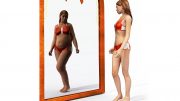
Muscle dysmorphia is a body dysmorphic disorder in which patients are obsessed with their muscularity and leanness.
According to the findings of a recent study, engagement in bulk and cut dietary cycles is associated with a larger desire to become more muscular among Canadian teenagers and young adults.
In the last 12 months, over half of males and one in five women, transgender people, and gender non-conforming participants engaged in a “bulk and cut” cycle, according to recent research that was recently published in the journal Eating and Weight Disorders – Studies on Anorexia, Bulimia, and Obesity.
In order to maximize the development of lean muscle mass and minimize body fat, an increasing number of people are practicing “bulking and cutting,” a dietary method that involves alternating between times of consuming excess calories (bulking) and reducing calorie intake (cutting), a practice that is in line with contemporary body ideals. Teenagers and young adults are particularly prone to it, especially those who are involved in the fitness world and who want to build a muscular and toned body.
The researchers examined data from over 2,700 Canadian adolescents and young adults and discovered that, across all participant groups, bulking and cutting was associated with a greater desire to become more muscular, highlighting the connection between this dietary approach and desires to alter one’s body.
“Bulking and cutting is a common practice within the fitness community, and is popularized by social media,” says lead author Kyle T. Ganson, Ph.D., MSW, assistant professor at the University of Toronto’s Factor-Inwentash Faculty of Social Work. “Given body ideals that focus on bulk muscularity and leanness in boys and men, it is not surprising that this dietary method was highly common in our sample, but it should also be noted that girls, women, transgender, and gender non-confirming participants, also face unique pressures to adhere to specific body types. For girls and women, this ideal is transitioning away from the thin ideal to a toned and fit ideal.”
Few studies, however, have explored and characterized engagement in bulk and cut cycles, or whether this dietary method is linked with the drive for muscularity and eating disorder and muscle dysmorphia psychopathology.
“Our findings also showed that engagement in bulking and cutting was associated with symptoms of eating disorders, as well as muscle dysmorphia, which is characterized as the pathological pursuit of muscularity, for men and women in the study,” says Ganson. “These findings are particularly salient given the documented increased prevalence of eating disorders and related behaviors during the COVID-19 pandemic.”
The study illuminates the importance of greater awareness of this unique dietary method, which may go unnoticed by healthcare and public health professionals.
“It is important that healthcare professionals screen for a vast array of dietary practices that may be harmful for young people, not just clinical eating disorder behaviors, like food restriction,” Ganson says. “We need to continue to research these forms of muscularity-oriented behaviors to better understand them and implement effective strategies to protect the health and well-being of Canadian young people.”
Reference: “‘Bulking and cutting’ among a national sample of Canadian adolescents and young adults” by Kyle T. Ganson, Mitchell L. Cunningham, Eva Pila, Rachel F. Rodgers, Stuart B. Murray and Jason M. Nagata, 9 September 2022, Eating and Weight Disorders – Studies on Anorexia Bulimia and Obesity.
DOI: 10.1007/s40519-022-01470-y









There is no problem here other than the eating disorders. The pursuit of gains in a holy matter between God and your muscles.